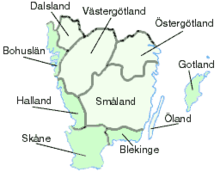Götaland
Götaland Latin Gothia [ ˈjøːtaland ] is the southernmost of today's three parts of Sweden (Swedish landsdelar ) Götaland, Norrland and Svealand .
geography
The area includes the ten historical provinces , also known as "landscapes" (Swedish landskap ), Blekinge , Bohuslän , Dalsland , Gotland , Halland , Öland , Östergötland , Småland , Schonen (Skâne) and Västergötland (Westergötland). Götaland's northern border stretches from the Baltic Sea in a westerly direction along the great lakes Vättern and Vänern to the Swedish-Norwegian border mountains in the north-west. To the north it borders on Svealand, which makes up the central part of Sweden.
Götaland has an area of 97,220.72 km² and a population of 4.88 million people.
History of the region
Other older names in the region are “Gothia”, “Gothlan [d]” and “Gotland”. It once consisted of sovereign kingdoms whose inhabitants were called " Gautar " in Old Norse . It is speculated that these are the "Geatas", the people of Beowulf from the old English epic of the same name. According to other speculations, the region was the place of origin of the Goths . As early as 150 AD, the inhabitants of the region were referred to as "Götarna" by the Greek geographer Claudius Ptolemy .
It was only in the late Middle Ages that Götaland began to be regarded as part of Sweden. In Old Norse and Old English sources it was described as an autonomous region independent of Sweden. Imperial councilor and landowner Bo Jonsson Grip described Sweden in a source from 1384 as consisting of the parts Svealand, Österland and Götaland. However, Karl Sverkersson had already proclaimed himself king of the Svear and Götar (Gautar), the two ethnic groups that apparently united all the tribes of Sweden. The name Sweden (Sverige) actually stands for "Zwerike" according to Erik Olofsson, which means "two realms" and describes the realms of Svear and Götar. The Swedish Empire, as it is said in "King Christoffer's national law, arose from the lands of the Svear and Götar as early as the pagan times."
In the early Middle Ages Småland, which consisted of the "countries" Njudung , Värend , Möre , Ydre , Tjust , Finnveden and Kinda , the island of Öland, Östergötland, Västergötland (including Dalsland) and Värmland and Närke belonged to Götaland. Värmland was still part of Götaland in the early 19th century. Värmland and Närke are now part of Svealand.
Blekinge, Bohuslän, Halland and Schonen were awarded Sweden in the Peace of Roskilde of 1658. Bohuslän previously belonged to Norway and the other provinces to Denmark . These provinces have belonged to Götaland ever since. The former Danish provinces are summarized as Skåneland .
Part of Sweden
In today's Sweden, the division into parts of the country is of marginal interest. It is mainly used in meteorology and summary statistics . Today, Södra Sverige (SE2, ' Southern Sweden ') is used for the NUTS 1 region , including Östergötland. In the legal field, the Göta Hovrätt (roughly: Götaland Higher Regional Court) keeps the memory of the former part of the country alive. However, the judicial district is smaller than historic Götaland. The region is economically shaped by both agriculture and industry. The crops grown include cereals, potatoes and sugar beets. Livestock is farmed in parts of the country. The branches of industry include the manufacture of motor vehicles, shipbuilding or quarries as well as the manufacture of glass, paper and fabrics. Götaland has been Sweden's most densely populated region since the mid-18th century.
See also
- Göta landsväg (the old "Göta road" from Stockholm to the south)
literature
- Wilhelm Friedrich Volger: Götaland, Gotland . In: Handbook of Geography . Hahn, Hanover 1833, p. 623–626 ( books.google.de - historical description).
- Götaland . In: Theodor Westrin (Ed.): Nordisk familjebok konversationslexikon och realencyklopedi . 2nd Edition. tape 10 : Gossler-Harris . Nordisk familjeboks förlag, Stockholm 1909, Sp. 886-887 (Swedish, runeberg.org ).
Web links
Individual evidence
- ↑ Emil Jacob Jonas: Sweden and its development in economic and intellectual relationships during the last decade . Berlin 1875, p. 6 ( Text Archive - Internet Archive ).
- ↑ Götaland Region ugeo.urbistat.com.
- ↑ a b Götaland region, Sweden. In: Encyclopædia Britannica . Retrieved May 26, 2020 (English).
- ↑ Hans Hildebrand: The pagan age in Sweden: an archaeological-historical study . O. Meissner, Hamburg 1873, p. 98 ( Textarchiv - Internet Archive ).

